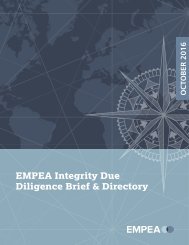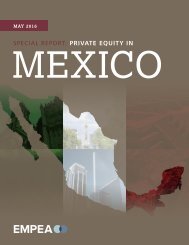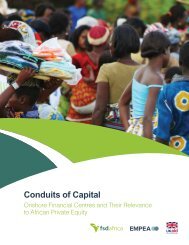MEXICO
1r3fkNK
1r3fkNK
Create successful ePaper yourself
Turn your PDF publications into a flip-book with our unique Google optimized e-Paper software.
EMPEA • MAY 2016 | 11<br />
(Continued from page 9)<br />
“When you look at the country’s GDP per capita and drill down to analyze different<br />
derivatives such as the growing middle class, credit expansion and the demographic<br />
dividend, you’ll see that there is a lot of economic power coming online in Mexico.”<br />
–Eduardo Cortina, The Abraaj Group<br />
The United States is by a large margin the principal trading partner<br />
of Mexico, accounting for 82% of Mexico’s non-oil exports and<br />
42% of its oil exports. 10 In particular, the automobile industry has<br />
become a key sector for Mexico, comprising 40% of exports in<br />
January 2016, the value of which has nearly doubled since 2010. 11<br />
In October 2015, the Mexican government signed the Trans-<br />
Pacific Partnership (TPP) agreement. Whether this will result in<br />
new investment opportunities and greater export potential for<br />
private equity firms, or simply increased competition, remains<br />
unknown. One investor explains that private equity players in<br />
Mexico are well positioned to help family-owned businesses take<br />
advantage of these agreements as they are very familiar with<br />
developing partnerships and participating in mergers and acquisitions.<br />
Nonetheless, the challenge of moving businesses north to<br />
the United States or to other developed trading partner counties<br />
remains great. “There are clearly going to be more opportunities<br />
for Mexican companies with the right management and the right<br />
resources to grow outside of Mexico,” notes Roberto Terrazas,<br />
Managing Director and Chief Investor Relations Officer of Nexxus<br />
Capital. “However, it will be a challenge; the success rate of companies<br />
moving to the United States has been quite low. You have<br />
to be well prepared and you have to be fit before entering that<br />
market—it’s going into the first league.”<br />
LONG AWAITED GOVERNMENT<br />
REFORMS<br />
Pacto por México, the suite of reforms proposed and partially<br />
implemented by President Enrique Peña Nieto beginning in 2012,<br />
has been groundbreaking. These reforms tackle inefficiencies in an<br />
enormous breadth of topics including taxation, education, transparency,<br />
energy sector ownership and free competition, and have<br />
sent a clear signal to investors that the government is sincere in<br />
its efforts to promote growth.<br />
Private equity participants, as well as the broader investment community,<br />
have been closely following the comprehensive energy<br />
reforms signed into law by Peña Nieto in August 2014, and which<br />
opened the energy sector to private investment. 12 Unfortunately,<br />
five months later, in January 2015, oil prices dropped below US$50<br />
per barrel, making many of the newly privatized oilfields less enticing<br />
to investors than they had been before the price movement.<br />
However, many local firms won tenders for onshore oil fields in<br />
the first three rounds of bidding, and this year, ten deep-water<br />
sites have been announced for future auction. 13 One stakeholder<br />
explains that although there has been a “gloomy sentiment” around<br />
the energy sector privatization in Mexico due to low oil prices, it is<br />
always good to remember that “one should invest when no one<br />
is interested because eventually the prices will recover.”<br />
In speaking with industry players, it is clear that many are optimistic<br />
that the impact of reforms will be long lasting. PineBridge Investments’<br />
Rodriguez claims, “Compared to other emerging markets<br />
both in and outside of the region, the reforms that Mexico has been<br />
able to implement in the last three years have been very important<br />
and translate to an attractive opportunity from a mid- to long-term<br />
perspective. It is going to take a lot of patience especially given<br />
what has happened to commodity prices over the last few years;<br />
however, the reforms are powerful because they are intended to<br />
be here for decades, not for one or two years.”<br />
One long-term drag on the Mexican economy has been the presence<br />
of monopolies and the lack of competitive markets, holding<br />
back both consumers and entrepreneurs. An OECD study estimated<br />
that prices in Mexico have been approximately 40% higher than<br />
they could have been if markets were more competitive. 14 This<br />
finding encouraged the government to implement a new Federal<br />
Antitrust Law. Passed in April 2014, this law bolstered institutional<br />
capacity to implement antitrust policy by giving more power to<br />
the Federal Competition Commission (COFECE), expanded the list<br />
of antitrust behaviors to be sanctioned, and clarified how the law<br />
should be applied. Industry participants expect these reforms to<br />
alter the economic landscape in Mexico. In particular, mid-cap<br />
companies will likely be the biggest winners from the reforms<br />
since they may now have a better chance of capturing larger<br />
market shares. 15 Finally, the overlapping financial reforms could<br />
increase competition in the banking sector and thus lower interest<br />
rates available to households and small- to mid-sized companies.<br />
Mexico’s resilience in a tough global macroeconomic environment,<br />
combined with the promise that structural reform entails, has rekindled<br />
investor interest in the market. Private equity investors are well<br />
suited to identify the companies that can best capitalize on Mexico’s<br />
progress—but is this story resonating with global investors?<br />
10. Banco de México, January 2016.<br />
11. Banco de México, January 2016 and February 2015.<br />
12. Brookings, 2014. See: http://www.brookings.edu/research/articles/2014/08/14-mexico-energy-law-negroponte.<br />
13. Forbes, 2016, and Wall Street Journal, 2015. See: http://www.forbes.com/sites/christopherhelman/2016/02/22/mexican-president-promises-success-of-historic-oil-reforms/#75cbf5723dfc<br />
and http://www.wsj.com/articles/mexico-auctions-onshore-oil-fields-amid-low-prices-1450199493.<br />
14. OECD. “Mexico Better Policies for Inclusive Development,” September 2012. See: http://www.oecd.org/about/secretary-general/2012%2009_Mexico_Brochure_EN.pdf.<br />
15. KKR, “Mexico: Different Investment Lens Required,” May 2014. See: http://www.kkr.com/sites/default/files/KKR_Insights_140519_0.pdf.





